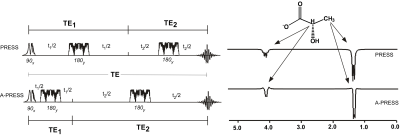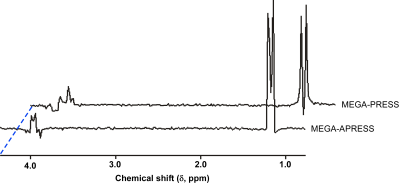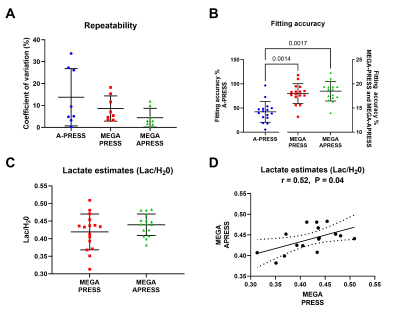2619
The combined use of MEGA- editing and asymmetric-PRESS methods improve the precision of cerebral lactate detection in healthy adults
Lauriane Jugé1,2, Iain Ball3, and Caroline D Rae1,2
1Neuroscience Research Australia, Sydney, Australia, 2School of Medical Sciences, University of New South Wales, Sydney, Australia, 3Philips Australia & New Zealand, North Ryde, Australia
1Neuroscience Research Australia, Sydney, Australia, 2School of Medical Sciences, University of New South Wales, Sydney, Australia, 3Philips Australia & New Zealand, North Ryde, Australia
Synopsis
Here, we combined two 1H-MRS methods that have shown utility for detecting lactate in the brain, MEGA- editing and use of an asymmetric-PRESS and compared this approach (MEGA-APRESS) with MEGA-PRESS and A-PRESS in phantoms and eight individuals. MEGA-APRESS showed improved precision compared to MEGA-PRESS. Both editing approaches were greatly superior to A-PRESS alone.
INTRODUCTION
Measurement of lactate (Lac), a by-product of glycolysis, has been hindered by the low concentration in the healthy brain (~1mM) and overlap of the methyl doublet at 1.31 ppm in 1H spectra by lipid and macromolecule signals1. Inversion of the doublet at longer echo times can reduce signal overlap, but better precision can be achieved by spectral editing. MEGA-PRESS (MEshcher-GArwood Point RESolved Spectroscopy)2 (TE ~ 144 ms) offers robust editing of lactate signal but necessarily includes a time and signal penalty. Asymmetric PRESS (A-PRESS, TE1/TE2 25/85 ms) also inverts the lactate doublet and is a single shot method but does not resolve overlapping signals (Figure 1). Here, we investigated whether selective editing combined with A-PRESS (MEGA-APRESS) could improve the precision of lactate detection and repeatability compared to MEGA-PRESS and A-PRESS.METHODS
1H MRS data were acquired at 3T (Philips Ingenia CX) using a dStream-32 head coil in 8 healthy adults (3 women, 31 ± 7 years) from a 3 × 3 × 3 cm3 volume-of-interest in the left parietal lobe and a 2L phantom (GE Braino base with 10 mM sodium lactate). All spectra were acquired with TR = 3000 ms, 1024 data points using VAPOR water suppression, B1 = 22 μT, using high bandwidth π/2 (FREMEX05) and π (FREMREF04) pulses. A-PRESS scan duration 4 min 54 s, 80 averages, Ed BW = 42 Hz), MEGA-PRESS and MEGA-APRESS (scan duration 8 min 15 s, 80 ON/OFF pairs, Ed BW = 27 Hz) were collected twice in randomised order to test intra-session repeatability along with a water reference. Data were analysed using QUEST (jMRUI, v4) fitting basis sets simulated using NMRSCOPE or, in the case of edited spectra, acquired from the phantom. For each participant, lactate estimates from edited spectra were referenced to the averaged water integral from A-PRESS (Lac/H20). Repeatability was analysed by computing the coefficient of variation. Fitting accuracy was assessed using the standard deviation of the fit generated by jMRUI. Repeatability and precision between the three methods were compared using repeated measures one-way ANOVA, followed by Tukey’s multiple comparisons test (GraphPad Prism, v9.2), while statistical differences in Lac/H20 estimates between MEGA-PRESS and MEGA-APRESS was determined with a paired t-test. Spearman correlation was used to investigate the relationship between Lac/H20 estimates.RESULTS
Spectra from the phantom edited by either editing approach are shown in Figure 2. In vivo, the coefficient of variation was the lowest for the MEGA-APRESS (4.4 ± 4.3 %) when compared to MEGA-PRESS (8.6 ± 5.8 %) and A-PRESS (13.8 ± 13.1%) (Figure 3A). Intrasession repeatability of Lac/H2O did not differ between all three methods (P = 0.20, n = 8), although MEGA-PRESS, and MEGA-APRESS showed good quality fits (18.0 ± 2.1 % and 18.5 ± 2.0 %, respectively), with both significantly lower than A-PRESS (42.2 ± 21.6%, P = 0.0005, n = 16) (Figure 3B). Lac/H20 estimates obtained from edited spectra did not differ between MEGA-APRESS and MEGA-PRESS (0.44 ± 0.03, and 0.42 ± 0.05, paired t-test, P = 0.08, n = 16) (Figure 3C). However, the confidence interval of Lac/H20 from the MEGA-APRESS scan was about half that obtained using MEGA-PRESS (95% confidence interval of the mean, [0.42-0.46] vs [0.39-0.45]). There was a weak correlation between different editing estimates (Spearman, r = 0.52, P = 0.04, n = 16) (Figure 3D).DISCUSSION
Using MEGA-APRESS with TE 25/85 for lactate detection allowed more robust quantification in healthy adult brains. It yielded an excellent intrasession reproducibility not achieved by the standard MEGA-PRESS and A-PRESS, without loss in fitting accuracy and with improved consistency.CONCLUSION
Edited spectroscopy with MEGA-APRESS improved in vivo brain lactate quantification in healthy adults. It will provide more certainty for measurement of lactate in pathology.Acknowledgements
The authors acknowledge the facilities and scientific and technical assistance of the National Imaging Facility, a National Collaborative Research Infrastructure Strategy (NCRIS) capability, at Neuroscience Research Australia and the University of New South Wales (Australia).References
1. Behar KL, Rothman DL, Spencer DD, Petroff OA. Analysis of macromolecule resonances in 1H NMR spectra of human brain. Magn Reson Med 1994;32:294-302.
2. Mescher M, Merkle H, Kirsch J, Garwood M, Gruetter R. Simultaneous in vivo spectral editing and water suppression. NMR Biomed 1998;11:266-72.
Figures

Figure 1. Sequence
diagram for PRESS (TE = 144 ms) and A-PRESS (TE1/TE2 25/85) and spectra of
lactate simulated (NMRSCOPE) with each.

Figure 2. Edited 1H
spectra from lactate phantom using MEGA-PRESS (TE 144 ms) and MEGA-APRESS
(TE1/TE2 25/85).

Figure 3. Comparison
of brain lactate measurements between 1H MRS methods: Intrasession repeatability
(A), fitting accuracy (B) and Lac/H20
estimates from edited spectra (C). Data are reported as mean ± standard
deviation,
and significant
Tukey’s multiple comparisons are reported on graphs A, B and C. D) Linear
regression of edited Lac/H2O estimates with 95% confidence intervals.
DOI: https://doi.org/10.58530/2022/2619